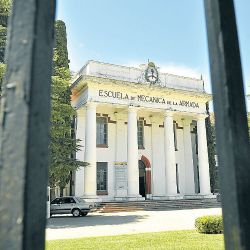Miriam Lewin stood up, her eyes wet with tears. She walked a few steps to Mabel Careaga. They embraced hugged each other and began to cry again. Their tears were ones of pain and joy, for the women’s celebrations were tinged with sadness and remembrance. Just moments before, judges had handed a life sentence in prison to Mario Daniel Arru, who in December 1977 commanded an aircraft which flew over the River Plate. During the flight, two French nuns, Alice Domon and Leonie Duquet, as well as the founders of Mothers of Plaza de Mayo humanitarian organisation – a group made up of people who were looking for their disappeared children – were drugged and then dumped, thrown from the plane, into the waters below. It was just one of the infamous “death flights” in which opponents of the last military dictatorship (1976-1983) were hurled from the skies into the watery depths.
Mabel’s mother was one of Arru’s victims. Miriam, a well-known reporter and a survivor of the dictatorship’s clandestine torture centres, had tracked Arru and the planes used in the flights. This week, Arru and another pilot, Alejandro Domingo D’Agostino found themselves in the dock alongside 46 other defendants, who were convicted and handed prison sentences this week by a federal oral court in Buenos Aires City. The verdicts came as part of the ESMA ‘megatrial,’ a case addressing crimes at the country’s most notorious detention centre from the era of state terrorism.
The judges, as they ruled on the human rights abuses committed at what was formerly known as the ESMA Navy Mechanics School, the existence of the death flights, the dictatorship’s very own ‘final solution’ for Argentina, was finally acknowledged for the first time.
On Wednesday, after five years of hearings during which they examined 789 cases of abductions – the longest human rights trial in Argentina’s history – judges Daniel Obligado, Leopoldo Bruglia and Adriana Palliotti sentenced 29 former Navy officers to life imprisonment, including some of the country’s most infamous human rights violators, such as Jorge Acosta, Ricardo Cavallo or Antonio Pernías.
Among them too was Alfredo Astiz, the so-called ‘Angel of Death’ who infiltrated a group of family members of disappeared people who used to gather at the Santa Cruz Church. Almost 40 years ago, on December 8, 1977, Astiz commanded the operation that would end in the kidnapping and abduction of some of the founders of Mothers of Plaza de Mayo, including Esther Ballestrino de Careaga – Mabel’s mother – and the two French nuns.
The group was taken to ESMA – which at that time housed the country’s most notorious clandestine detention centre, a place where approximately 5,000 political prisoners were illegally detained during the junta’s reign. According to the testimonies of some of the survivors of that concentration camp, we now know today that those directing the camp did everything they could to justify their actions. Captain Acosta, some survivors say, feared that international pressure would grow over the nuns’ detention.
He came up with a plan and ordered a prisoner to prepare a banner with the name of the armed Peronist organisation Montoneros and to photograph Domon and Duquet with it, pretending instead that they have been abducted by that group.
Nora Cortiñas was at the Santa Cruz Church on December 8, 1977, when the members of the groups were kidnapped. They were collecting money to pay an advertisement in a newspaper to demand information from the government about their children. She was also present at the courtroom earlier this week to listen to the verdict. “Repressors have never thought the entire world would learn of the crimes they committed,” the 87-year-old human rights leader said, as she walked arm in arm with Mirta Baravalle, another member of Mothers of Plaza de Mayo – Founding Line.
Cortiñas and Baravalle had listened to the sentencing reading inside the courtroom in the courthouse located in the neighbourhood of Retiro, which lasted four hours. Estela Barnes de Carlotto, the leader of Grandmothers of Plaza de Mayo, was also present in the court along Rosa Roisinblit – the 98-yearold vice-president of Grandmothers of Plaza de Mayo, whose daughter was taken to ESMA. There, in that dark site, the young lady gave birth to her son. The baby was then taken away, snatched. In 2000, that child, now an adult, recovered his real identity.
In the court, a glass separated the area where judges, prosecutors, lawyers, defendants and some of the plaintiffs sat from the public. When the hearing ended, Víctor Basterra’s face showed great relief. “I have been testifying before court for 33 years,” said Basterra, who was kidnapped in 1979 and sent to the clandestine detention centre.
Under the orders of the officer, he was forced to work as a photographer and a graphic worker until the day democracy returned to Argentina. As a result of his work, he managed to take out some of the pictures of the human rights violators carrying out the crimes and of some of the prisoners that had been held there. When he was allowed to visit his family outside ESMA, he would smuggle photographs out, hiding them under his clothes. Once safely outside the compound’s walls, he would hand them to human rights organisations who were seeking evidence of the crimes committed by the dictatorship’s death squads.
“Many of those whose pictures I smuggled out from ESMA are now facing trials,” he said with pride.
DEATH FLIGHTS
“I could have been killed in a death flight when I was 20,” Miriam Lewin said on Thursday, as she sat a café in the City neighbourhood of Chacarita. Miriam was abducted in May 1977 and taken to another clandestine detention centre known as Virrey Cevallos, which was commanded by the Air Force.
In March 1978, she was transferred to the ESMA and her identity would instantly erased. When she arrived, they gave her a number: 090.
Thankfully she did not die there. Lewin, in fact, would live to become a key part of the quest for justice. It was she who pushed an investigation forward that led to the identification of the aircrafts used by the Prefecture (Coast Guard) – which during the dictatorship years came under the umbrella of the Navy – to throw drugged prisoners into the waters of the River Plate.
A couple of years ago, Italian photographer Giancarlo Ceraudo asked her if she knew where the aircrafts used in the death flight were today. Using her skill one of the country’s most-wellknown investigative reporters, she sought to answer the question.
She discovered that in 1971 the Coast Guard bought five Skyvans – two of which were destroyed in the 1982 Malvinas War. The three remaining ones were sold to a company based in Luxembourg, which only kept one. Another was traded to a defence company that provided services to Great Britain. The third one, the PA-51, was based in Fort Lauderdale, in Florida, United States. It had been purchased by a private airmail company called GB AirLink. A freelance reporter was asked to meet the owner of the PA-51 in Florida. The reporter made a startling discovery – the owner still had forms carrying the details of the flights carried out by that aircraft. Miriam immediately contacted two pilots who refused to appear before camera or before a court. Enrique Piñeyro, a former pilot and a famous film director, was the only one who cooperated and he would play a key role in the investigation.
One of the forms revealed that the PA-51 took off on December 14, 1977 from the Aeroparque airport in Buenos Aires City. It flew for three hours and 10 minutes and returned to the same place. “Night navigation,” it read on the form. Using information provided by the Coast Guard in 2010 it could be confirmed that Arru was one of the pilots commanding the flight, along with Enrique de Saint Georges. Until then, both had served as pilots for Aerolíneas Argentinas. The third pilot was Alejandro Domingo D’Agostino, who at that stage was meant to be retired.
According to testimony from survivors heard by the court in the ESMA trial, the last time the members of the group who were kidnapped in the Santa Cruz Church were seen alive was December 14,1977. Their bodies appeared near the coast of General Lavalle in Buenos Aires province between December 20 and 29, though they were only identified in 2005. Miriam had found the aircraft used to eliminate the two French nuns and the founders of Mothers of Plaza de Mayo.
Argentina’s own Final Solution De Saint Georges died in February. He did not get to receive the verdict issued on Wednesday. In total, 14 of the 68 defendants who faced trial for crimes related to the ESMA clandestine detention centre passed away or were declared too ill and unfit to face trial during the five years the proceedings took.
Arru and D’Agostino were the only pilots convicted in court. Rubén Ricardo Ormello, Julio Poch and Emir Sisul Hess were acquitted, despite documents provided by the prosecutors showing that the Navy’s aircraft were also involved in the death flights. Testimony before the court revealed how the three of them had boasted of having dumped drugged prisoners to the waters. The grounds for the ruling will be issued in March next year, but the difference in the sentences given to the death flight pilots depends on their institutional affiliation: while Arru and D’Agostino belonged to the Coast Guard, the three others were part of the Navy.
One of the judges explained to the Times this week that during the trial the workings of the death flight programme had been laid out. Every Tuesday, a group of senior officers would meet at the ESMA to decide on the names – in fact, the numbers – of the prisoners who were going to be “transferred,” a euphemism used to avoid speaking directly of killings. On Wednesday, a guard would then call the chosen numbers.
The detainees were told they were going to be transferred to a legal prison in the south of the country. Then they were injected with Pentothal, which numbed the prisoners before being taken to the planes. Lewin recalls how some prisoners who were drugged were then taken back to “Capucha” (“hood”), an area in the third floor of one of the buildings. There, detainees were piled up on top of each other. That was the first piece of information they got, she says, that hinted at the final destination for their comrades.
Reports about the death flights started to circulate during the dictatorship years, prosecutor Mercedes Soiza Reilly said during her final argument. On March 1977 – before being killed by an ESMA death squad – journalist Rodolfo Walsh wrote a letter mentioning the appearance of bodies on the coasts of Uruguay. In 1978, Horacio Maggio – a prisoner who managed to escape from ESMA but was later recaptured and killed – reported that helicopters were being used to get rid of the dictatorship’s opponents.
On March 1983, former police officer Rodolfo Peregrino Fernández filed a complaint, saying that the Coast Guard aircrafts were used to throw prisoners into the sea. In 1984, a letter signed by “young and honest members of the Coast Guard” reported the use of the Skyvans to eliminate detainees. The existence of the flights was also confirmed by Raúl Vilariño, an officer who served at ESMA. But it wasn’t until 1995 that the death flights hit the headlines, with a confession by Adolfo Scilingo to journalist Horacio Verbitsky.
AN ICON
Located on Avenida del Libertador, where cars come and go from the city of Buenos Aires to the northern part of the province, the ESMA stands as an icon of state terrorism in Argentina.
Maggio’s assertions in 1978 and those by three women who survived being detained there, in 1979, provided clear information about the atrocities that were happening behind the closed doors of this enormous Navy property during the initial years of the dictatorship.
The vast majority of local media outlets, however, failed to report what was going on. Yet for those who lived in fear for their lives, ESMA’s reputation certainly preceded it. In 1977 alone, the ESMA death squads kidnapped Swedish teenager Dagmar Hagelin, the French nuns, the founders of Mothers of Plaza de Mayo and wounded Walsh on the street.
“Where wouldn’t you like to be?” Elisa Tokar remembers being asked by one of her captors in 1977. As a militant, she had already heard the rumours of what was happening there. “In the Mechanics School,” she said. “You’re in the Mechanics School,” came the ominous response.
The Navy, in charge of the Ministry of Foreign Affairs, was responsible for counteracting the so-called “anti- Argentine campaign.” To this end, among other things, it set up the Pilot Centre in Paris, which was also investigated in this trial.
In 1979, when the Inter-American Commission on Human Rights (IACHR) arrived in the country, it went to visit the ESMA for inspection. The Navy officers had taken pains to modify the building so that it did not match with the reports the IACHR had already collected, muddying the waters. They even came up with a way to deal with the detainees – they were taken to an island called El Silencio in Tigre, which belonged to the Catholic Church.
The crimes committed at that dark site are appalling. In the ESMA, women suffered sexual violence and were forced to have sexual relations with their captors. A work plan for slaves was implemented, which ranged from working in the buildings to for the newspaper that former Admiral Emilio Eduardo Massera. Miriam Lewin was forced to do press work. “I don’t know how they didn’t kill my vocation,” she jokes today.
Andrea Bello remembers what she thought when the ESMA taskforce kidnapped her in December 1978,: “I am 20 years old, I have only lived for a short time.”
Like Lewin, she was lucky, she survived. As part of Bello’s work detail, she came into contact with some of the charts on which Navy officers used to write down the names of their victims. She managed to hide them in her boots and pass the names on when she was taken to visit her family.
Bello listened the verdict on Wednesday with her lawyers and Walsh’s daughter, Patricia. She was annoyed by the acquittal of three of the pilots. “So only two pilots disappeared all our comrades?” she wondered rhetorically in the aftermath.
So far there have been three trials addressing crimes committed at the ESMA.
The first one ended abruptly on December 10, 2007 when the only defendant, Héctor Febres – who distributed the babies seized at the clandestine maternity at ESMA, was found poisoned. At the second trial in 2011, 16 perpetrators were convicted.
In April, the fourth trial for crimes committed at the ESMA will begin. The court will have to examine the role of ten defendants in a thousand cases. “All I can say is that the struggle continues,” Bello said outside the courthouse, as she hugged her daughter.





























Comments